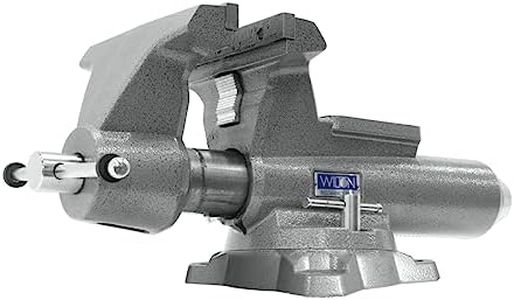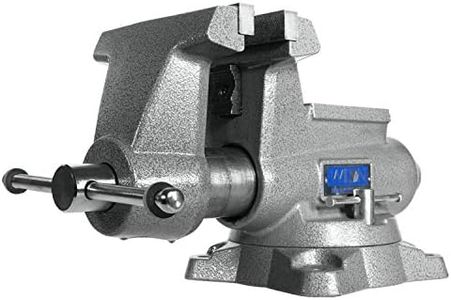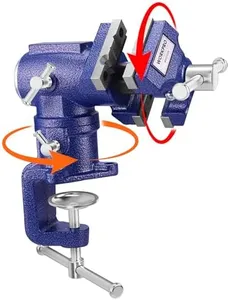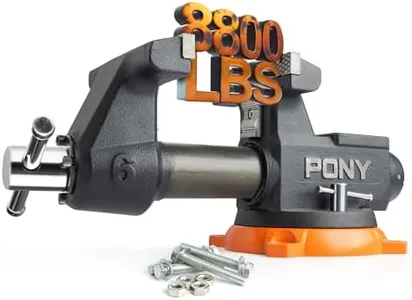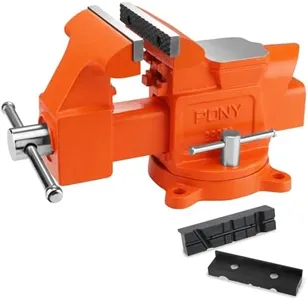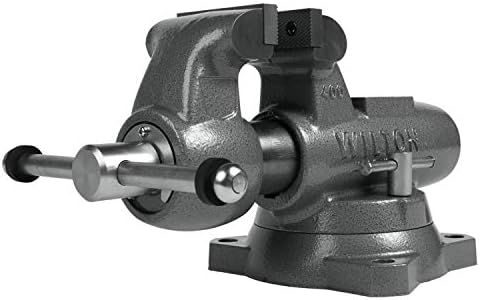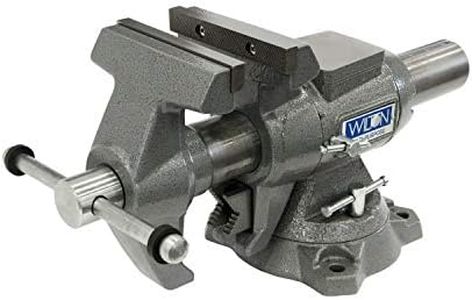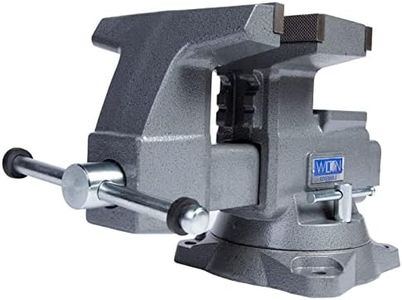10 Best Bench Vises 2025 in the United States
Our technology thoroughly searches through the online shopping world, reviewing hundreds of sites. We then process and analyze this information, updating in real-time to bring you the latest top-rated products. This way, you always get the best and most current options available.

Our Top Picks
Winner
Wilton Mechanics Pro Bench Vise, 10" Jaw Width, 12" Jaw Opening, 5-1/4" Throat (Model 8100M)
The Wilton Mechanics Pro Bench Vise is a solid choice if you need a heavy-duty, reliable vise for workshop or industrial use. It features a 10-inch jaw width and a 12-inch jaw opening, which provide plenty of space to hold various materials securely. With a 5-1/4 inch throat depth, it can grip objects at a decent distance from the mounting point, making it versatile for different projects. The vise’s body is made from ductile iron and alloy steel, balancing durability with a lighter weight compared to traditional cast iron, although it still weighs over 115 pounds, so it's best suited for a fixed workbench.
A standout feature is the 360-degree swivel base, allowing you to rotate your workpiece easily without repositioning the vise itself. This swivel base also has dual lockdowns, ensuring stability when locked in place. The vise includes a precision-machined slide bar for steady jaw movement, and the enclosed spindle keeps lubrication in while blocking dirt for smoother operation. The needle roller thrust bearing helps you apply strong clamping force without requiring excessive effort. Additionally, there’s a built-in anvil surface for light hammering tasks. Backed by Wilton’s lifetime warranty, this vise is built to last.
Its hefty weight means it’s not portable, and the large size may require a spacious workbench. If you’re after a durable, professional-grade bench vise with smooth operation and good adjustability, this Wilton model is a dependable option.
Wilton Utility HD Bench Vise, 8" Jaw Width, 8-1/2" Jaw Opening, 4-1/2" Throat (Model 648UHD)
Most important from
640 reviews
The Wilton Utility HD Bench Vise with an 8-inch jaw width and 8-1/2 inch jaw opening offers a solid grip for most common clamping jobs, making it suitable for both amateur and professional users. Its 4-1/2 inch throat depth provides enough reach for many standard workpieces. The vise features a 360-degree swivel base with dual lockdowns, giving you flexibility to position and secure your work comfortably. Made from durable cast and ductile iron, it promises long-lasting strength and stability under heavy use. The replaceable hardened steel jaws have a serrated pattern that enhances grip and durability, and built-in pipe jaws add versatility for pipe-related tasks. Plus, the large anvil surface lets you shape and form materials with ease. The powder-coated finish helps resist scratches, maintaining the vise's appearance over time.
One possible drawback is its weight of about 79 pounds, which could make it less portable if you need to move it frequently. Also, while the jaw opening is good for general use, it may be limiting for very large materials. Supported by Wilton’s lifetime warranty and positive customer feedback, this bench vise serves as a reliable and versatile tool for most workshop needs.
Most important from
640 reviews
Wilton Mechanics Pro Bench Vise, 6-1/2" Jaw Width, 6" Jaw Opening, 4-3/8" Throat (Model 865M)
Most important from
288 reviews
The Wilton Mechanics Pro Bench Vise is a solid choice for anyone needing a durable and versatile vise for workshop or industrial use. Its 6.5-inch jaw width and 6-inch jaw opening offer a good balance, allowing it to securely hold medium-sized workpieces without being too bulky. The 4.3-inch throat depth lets you reach further into your workpiece for better grip. Made from high-strength ductile iron and alloy steel, it offers excellent durability while staying lighter than traditional cast iron models.
One great feature is the swivel base that rotates a full 360 degrees with double lockdowns, giving you flexibility to position your work at any angle. The built-in anvil area is useful for light hammering tasks, adding to its versatility. The precision-machined slide bar and enclosed spindle ensure smooth, stable clamping and protect the mechanism from dust and debris. Plus, the needle roller thrust bearing helps deliver strong clamping force with less effort.
Weighing 55.6 pounds, it’s heavy enough to stay steady during use but may require a sturdy bench for mounting. While it’s not the largest vise available, its size and features make it ideal for mechanics, metalworkers, and hobbyists who need reliable medium-duty clamping. The lifetime warranty provides added peace of mind. For very large or heavy-duty tasks, a bigger model might be necessary, but this Wilton vise performs excellently for most general workshop needs.
Most important from
288 reviews
Buying Guide for the Best Bench Vises
When choosing a bench vise, it's important to consider the specific tasks you'll be using it for. A bench vise is a versatile tool that can hold materials in place while you work on them, making it essential for woodworking, metalworking, and other DIY projects. To find the best fit for your needs, you'll need to understand the key specifications and how they impact the vise's performance and suitability for your tasks.FAQ
Most Popular Categories Right Now


